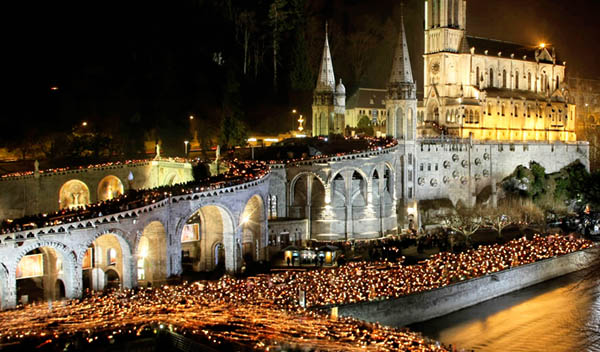

Since the National Pilgrimage of 1888, the great pilgrimages of Lourdes presented a peculiar characteristic: a Eucharistic demonstration in which the Divine Sacrament causes Its glory and Its power to shine more strikingly. Of course Jesus Our Savior was never forgotten amidst the pious homage tendered by the crowds to His Most Holy Mother. It must also be remembered that if Mary worked miracles upon souls and bodies, it was always through the omnipotent virtue of Her Son—Who is God, the sole Author of all these wonders. But that year, as the Journal de Lourdes remarks: "It has pleased our good Mother to efface Herself that Her Divine Son might shine forth in the Eucharist."
The 21st of August, 1888, was for the National Pilgrimage a day of trial: there were few cures, and towards evening a terrible storm prevented the torch-light procession from taking place. At the sight of the saddened, though not discouraged, pilgrims an inspiration from Heaven had suddenly dawned in the heart of a pious ecclesiastic. Why should not the Blessed Sacrament receive a triumphant ovation? And as the God of the Eucharist was being carried among the sick, why should not the multitude address Him with the same acclamations, the same prayers which in the days of yore had obtained the miracles which occurred during the mortal life of the Savior? This plan was, of course, favorably accepted.
The next day, at four o’clock in the afternoon, Jesus in the Blessed Sacrament was leaving the Basilica preceded and followed by a great number of the Faithful bearing tapers in their hands. After Benediction, given in the Grotto, the invocations began, with an animation, a stress, an enthusiasm quite indescribable. A spirit of Heaven-sent rapture descended upon the crowd. From all the pallets, from all the beds, from all the vehicles where human infirmity lay prone and suffering, something heart-rending, supplicating, came forth; and as though by a unanimous impulse, the crowd called upon the Son of the Immaculate, as of yore did the paralytic and the blind man of Jericho, "Lord! if Thou wilt, Thou canst heal me!" But now, behold! in front of the Grotto eight of the sick have arisen! How describe such things? When the Magnificat was intoned, triumphant, prodigious, no one could restrain his tears. And every year after, in the numberless processions that unwind themselves near the blessed Grotto, the same enthusiastic faith bursts forth; the same ardent prayer on the part of the Faithful, the same prodigies of merciful power on the part of Jesus Christ present in the Blessed Sacrament take place. It is Mary at Lourdes who has really prepared the Eucharistic triumph of Her Son. (Les Miracles historiques du Saint Sacrement, par le P. Eug. Couet)
Modern "science" has for a long time sought the secret of the cures in the waters of the spring at Lourdes. The temperature of the water, its composition, all has been brought forward. "How do we know," said one 'scientist', "that in certain circumstances a bath in ice water might not save a consumptive?" And so it happens that, by one of those seeming whims of Providence, the original plan of Lourdes seems abruptly modified; a new appeal makes itself felt.
It is not only in the baths, where the patient is surrounded by a certain mystery—it is during the procession of the Blessed Sacrament, in the full light of day, under the eyes of a thousand witnesses that the cures take place.
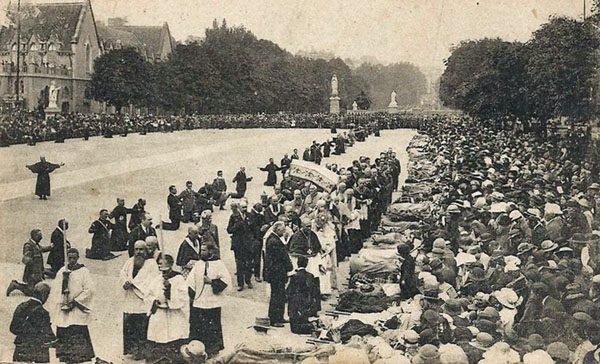 They wanted to keep our God a silent Prisoner, enclosed in the Tabernacle. Behold! He comes forth. He passes through the crowds, His divine rays more resplendent than gold and precious stones, dazzle our eyes, bring back life to those who are dying on their beds, leading them after Him triumphant and transformed; they penetrate the crowds and warm hearts and souls frozen and benumbed for years. Miraculous cures, miraculous conversions! Who can enumerate them?
They wanted to keep our God a silent Prisoner, enclosed in the Tabernacle. Behold! He comes forth. He passes through the crowds, His divine rays more resplendent than gold and precious stones, dazzle our eyes, bring back life to those who are dying on their beds, leading them after Him triumphant and transformed; they penetrate the crowds and warm hearts and souls frozen and benumbed for years. Miraculous cures, miraculous conversions! Who can enumerate them?
It is interesting to study these manifestations which have been spreading since the year 1888. With them, all that constitutes the real life of the pilgrimages is developed; the crowds are greater; the Communions are more frequent, for that is the hearth from which supernatural life draws nourishment.
It was in 1888 that for the first time we kept statistics of the cures which occurred where the Blessed Sacrament passed. That year they reached a proportion of sixteen per cent—about a sixth; seven cures at the processions to forty at the baths. A great number of cures remained unreported as to place and manner. Often a cure begins at the baths and terminates at the procession; more rarely, a cure begins at the procession and is completed at the baths. In a great number of cases where there had been no results at the baths, the cure took place before the Blessed Sacrament instantly.
The first cure mentioned to us was that of Nina Klin, a young woman of twenty-two, just out of the Paris hospitals. A container holding 25 pints of sulphuric acid had been spilled over her and she had been deeply burned. The nerves of the leg had been compressed in the scar, and for ten months she had been unable to move at all. Every treatment had been tried in vain—massage, electricity—no results had been obtained. Nina Klin had come with the National Pilgrimage. She was twice immersed in the baths, but felt no improvement. On August 22 she was lying on a mattress in front of the Grotto when the Blessed Sacrament passed beside her. She was suddenly lifted up by a violent impulsion, and jumping from her bed she broke through the litters that surrounded her and followed the procession with an assured step.
Since 1888 the proportion of cures which have taken place at the passing of the Blessed Sacrament has continually increased at Lourdes. They rose rapidly from one-sixth to one-fifth, one-quarter, one-third, and at last to one-half, which was exceeded in 1894 and in 1898. We find, in this last year, forty cures at the procession as against thirty-five at the baths. There were a few fluctuations in 1891, 1892 and 1895, but as an average during those ten years the cures at the processions increased to sixty per cent.
The sick, however, did not wait for our statistics to notice these coincidences. They hasten to come and group themselves in the Esplanade of the Rosary. They prefer to come there during the pilgrimages to take part in the great Eucharistic manifestations, for they know that many cures will be incontestably proved during these ceremonies.
In 1889 we find some very interesting cures. Here is a young blind girl, Mary Louise Horeau, nineteen years old, who does not distinguish the day from the night. She has to be both led and fed. She had suffered from recurrent Keratitis, deeply seated eye trouble, her eyes having lost their clarity. She has not been able to get near the Grotto, so she waits by the baths, having begged her friend to notify her the moment Our Lord comes near her. The Blessed Sacrament arrives surrounded by the acclamations of the crowd. "Here He comes!" says the friend of the poor blind girl. The sick one falls upon her knees. "Lord," she cries, "if Thou wilt, Thou canst cure me! Lord, make me see!" Instantly a blinding light crosses her line of vision; she feels a very acute pain, and her eyes are opened. She distinguishes the Grotto, the kneeling crowd—and Jesus, radiant with glory, Who has blessed her. Her sight is restored; she can see the finest, most delicate objects. We examine her eyes; they are limpid and perfectly clear.
Mrs. Facq, from Pont-à-Mousson, mother of ten children, forty-four years old, who had been paralyzed for five years: she was carried to the baths in a fainting condition—dying. Should they bathe her while in such a state? But there is no hope, the Sisters say, if the Blessed Virgin does not cure her! Eight of the Lady Helpers go to work. They undress the poor patient. She is immersed in the water. Once in, the hiccoughs begin; her lips grow livid. It is the agony—the end. The prayers for the dying are recited. At that moment the little bell announcing the approach of the Blessed Sacrament is heard. Quickly they carry the patient along the way of Its passage, under torrents of rain. The Lady Helpers fall on their knees around the patient and try to raise her head. Vain efforts, the head falls back and the eyes remain closed. At this moment the Blessed Sacrament arrives. All of a sudden the patient raises herself; her eyes open and become fixed on the ostensorium. She rises, she stands, she walks to meet the Blessed Sacrament. She falls on her knees at His feet. The ostensorium is placed on her head. She rises at once, and bare-footed, in the mud, her face beaming with joy, she walks behind the dais and it is with great trouble that she is prevented from climbing thus far as the Basilica; it is only in front of the Pilgrim's Asylum that she can be stopped.
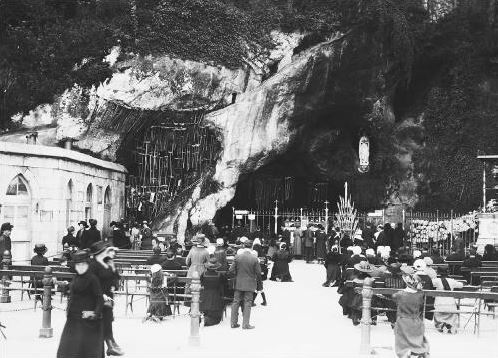 We could also recall the cure of young Guy, from Montpelier. He had been cared for in the hospital for a long time without results. He had a lifeless, paralyzed, atrophied arm—the discolored cuticle came off in patches. With his good hand he raised the splint which held his bad arm and touched the ostensorium. Immediately he felt a violent shock and heat, power and life returned instantly to the paralyzed member. He removed the apparatus to find himself absolutely cured.
We could also recall the cure of young Guy, from Montpelier. He had been cared for in the hospital for a long time without results. He had a lifeless, paralyzed, atrophied arm—the discolored cuticle came off in patches. With his good hand he raised the splint which held his bad arm and touched the ostensorium. Immediately he felt a violent shock and heat, power and life returned instantly to the paralyzed member. He removed the apparatus to find himself absolutely cured.
Beside him was a twelve-year-old child who had never walked; affected with suppurative tubercular hip disease. When the Blessed Sacrament passed before him, he seized the humeral veil with both hands and held back the priest who carried the ostensorium. In vain did they try to make him loose his hold. "No," he said, "I will not give in until I can get up cured!" And after struggling a few moments, he surely did rise before the wondering crowd, which rushed after him and carried him triumphantly.
I have said that we had reached sixty per cent for cures at the passing of the Blessed Sacrament; this proportion has been exceeded. In 1898 the pilgrimage from Arras found that all its patients were cured during the procession. For ten or twelve years, the great rendezvous where the deepest homage has been paid to the Eucharist is Lourdes.
These manifestations, which at first were limited to the National Pilgrimages, have been adopted by all the pilgrimages. They are loved by all peoples and form for the future a part of all great religious ceremonies. In the footsteps of our missionaries, with the devotion to Our Lady of Lourdes, they have reached and penetrated the most remote places.
The story of the cures effected since 1888, along the line of the processions, makes one of the finest pages ever written on Eucharistic wonders. (From the report of Dr. Boissarie read at the Eucharistic Congress at Lourdes in 1898.)
Dr. Boissarie's report speaks of hundreds of cures, and indeed thousands have claimed to have been cured at Lourdes. But fewer than seventy cures have been "fully authenticated." This is because of the strict process of examination and authentication established by the Medical Bureau, which was established in 1882 to investigate the cures taking place at Lourdes. This Bureau is Mary's challenge to the scientists and other intellectuals who say there is no such thing as the supernatural.
The Medical Bureau has been open to all doctors who care to visit it. These doctors are invited to examine any pilgrims who claim to have been cured, and they are free to go through the files of the Bureau. The visiting doctors are of all nationalities and of all religious persuasions.
The pilgrim who claims to have been cured must have a certificate from his local physician saying that he suffers from an incurable malady. This is all important. If he does not have this, or it is too vague, he is not examined at all. If his certificate is satisfactory, the pilgrim undergoes a most intense examination. The Bureau can make four possible decisions regarding his case: (1) no cure has taken place; (2) there has been only a partial cure; (3) the cure is complete, but some natural explanation might be given; (4) the cure is complete, and no natural explanation can be given. It is only the last class in which the Bureau is further interested. The cure is not certified, however, unless the pilgrim comes back a year later for another examination. The Bureau wishes to be sure that there has been no relapse. Understandably, the vast majority of those who claim to have been cured do not wish to submit themselves to this kind of invasive and intense examination.
The word miracle is never used by the Medical Bureau. It merely certifies that a case which had been considered incurable has been cured. The Church’s position on miracles is simple: Miracles are perfectly possible. God made the natural laws, and He can set them aside any time He wishes. It is seldom, however, that the Church declares, "This is a miracle." The cures that have taken place at Lourdes are not certified as miracles, although people all over the world are accustomed to refer to them as such. Father McSorley in his book, Outline of Church History, says that, in the fifty years following 1858, some four thousand medically miraculous cures were recorded at Lourdes, though only a few were certified.
Particularly fascinating is the perpetual miracle of Lourdes. At the hospital, the patients have been segregated according to sex but not according to disease. Persons with many different kinds of sickness have been packed together in one room as close as the beds will fit. At the baths, the water used to be changed only twice a day. Patients with running sores, with cancerous growths, and with every kind of infectious disease were plunged in one after another. Yet, neither in the hospitals nor in the baths was there ever a case of a patient contracting a new disease or becoming worse from these conditions.
At the beginning of the 20th century, a group of doctors tried to close Lourdes on the grounds that it was unsanitary. Their attempt failed because they could not find a single case of infection resulting from a visit to the shrine. "At Lourdes," an English nurse once said, "we find Our Lady putting microbes and bacilli in their place."
What do men of "science" have to say about all this? Most of them simply refuse to recognize Lourdes. "Miracles are impossible," they say. And that is that. Dr. Alexis Carrel, a Noble Prize winner, was asked to leave the University of Lyons because he said that one of his patients had been cured at Lourdes. When Dr. Carrel's book, Man the Unknown, appeared, the New York Times printed letters from other doctors who seemed to think that Carrel was the victim of superstition or that he had lost his mind. The amazing thing about this is that Dr. Carrel had visited Lourdes several times and had personally examined pilgrims before and after their cures, while his adversaries were not even acquainted with the story of the shrine. Ordinarily the rule of the scientist is: investigate, investigate, investigate. In the case of Lourdes, as with evolution, most "scientists" act in a strangely unscientific manner.
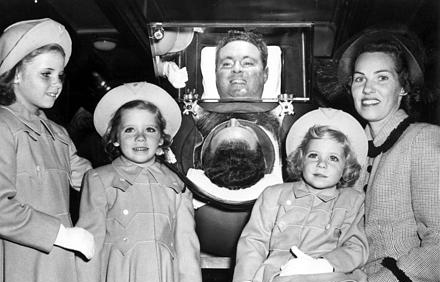 More wonderful than the cures of the body that have taken place at Lourdes are the cures of the soul. "The trip to Lourdes is never made in vain," is a common saying among the bath attendants, the stretcher bearers, and the hospital workers of Lourdes. Among the uncured pilgrims this is especially evident. A person who comes to the shrine to ask his own cure usually ends up by praying for others instead of himself.
More wonderful than the cures of the body that have taken place at Lourdes are the cures of the soul. "The trip to Lourdes is never made in vain," is a common saying among the bath attendants, the stretcher bearers, and the hospital workers of Lourdes. Among the uncured pilgrims this is especially evident. A person who comes to the shrine to ask his own cure usually ends up by praying for others instead of himself.
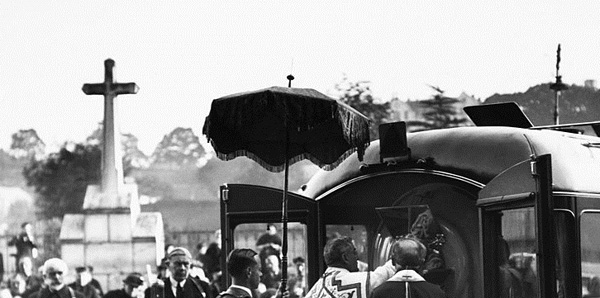 Fred Snite, the "man in the iron lung," (see photos, with family — right; receiving the Blessing of the Sick with the Most Blessed Sacrament at Lourdes — left) received a great amount of publicity when he went to Lourdes in 1936. He was not cured, but he says the time spent in Lourdes was a period of great spiritual consolation to him. He named one of his daughters Bernadette. It would be difficult to find a case of more perfect resignation. As he lay on his back in his iron lung, in obvious discomfort, he would say, "I feel that for some reason God has selected me to suffer. I look upon this as my ticket to Heaven." This is the typical attitude of the uncured pilgrims. It is Our Lady's gift to them.
Fred Snite, the "man in the iron lung," (see photos, with family — right; receiving the Blessing of the Sick with the Most Blessed Sacrament at Lourdes — left) received a great amount of publicity when he went to Lourdes in 1936. He was not cured, but he says the time spent in Lourdes was a period of great spiritual consolation to him. He named one of his daughters Bernadette. It would be difficult to find a case of more perfect resignation. As he lay on his back in his iron lung, in obvious discomfort, he would say, "I feel that for some reason God has selected me to suffer. I look upon this as my ticket to Heaven." This is the typical attitude of the uncured pilgrims. It is Our Lady's gift to them.
But the spiritual consolation of Lourdes is not confined to the physically afflicted. All pilgrims who devoutly approach the shrine and pray go away refreshed in spirit, more devoted to Our Lady, closer to Her Divine Son.
Contact us: smr@salvemariaregina.info
Visit also: www.marienfried.com